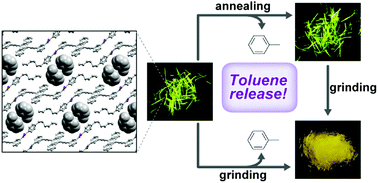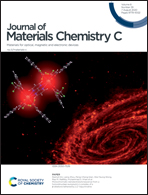Mechanical and thermal stimuli-induced release of toluene included in luminescent crystals as one-dimensional solvent channels†
Abstract
Luminescent materials that change their photophysical properties and molecular arrangement in response to external stimuli have attracted attention because of the potential application in sensors, memory, security inks, and informational displays. The combination of external stimuli-responsive luminescence with the release of volatile molecules would give more sophisticated photofunctional materials. Herein we discuss a 9,10-bis(phenylethynyl)anthracene derivative that formed green-emissive crystals containing one-dimensional toluene channels. Amide groups of the compounds formed linear hydrogen-bonds in the crystals. Thermal treatment resulted in a phase transition to another crystalline state with the release of the guest toluene molecules. However, little alteration in the photoluminescent properties occurred during the transition. Mechanical stimuli led to the release of volatile molecules along with an emission colour change with a transition from the crystalline to an amorphous phase. Infrared spectroscopy showed that linear hydrogen bonds remained after a thermal treatment-induced phase transition, whereas mechanical stimuli disturbed them.



 Please wait while we load your content...
Please wait while we load your content...